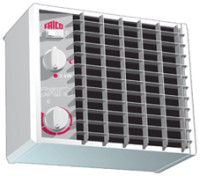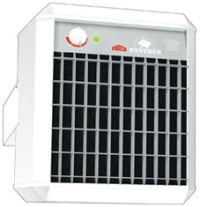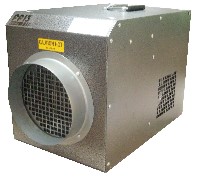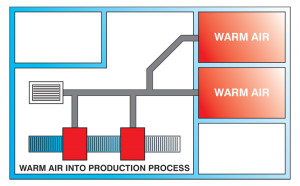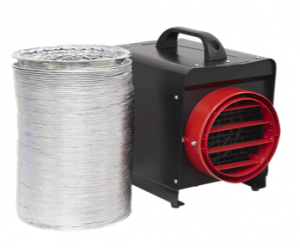
A Guide To Electric Industrial Fan Heaters
The choice in the market for industrial fan heaters is vast, so its worth taking a moment to get to grips with some of the basics that will enable you to narrow the selection and make your choice that bit easier.
In this page we cover;
|
|
|
Applications for Industrial Fan Heaters
Electric industrial fan heaters are seldom used as the only heating source in the workplace. Typicaly the mainstream heating might lack capacity in the coldest weather, or may not quite reach certain areas of the building. It is supplementary heating that industrial fan heaters are most useful. In some applications the lack of mains gas or a centralised heating system means companies have to use electric industrial fan heaters as their principle heat source. However, despite their effectiveness, versatility, relative low-cost and ease of installation they are seldom the cheapest way to heat in an industrial application.
Expectations and Perceived Faults with industrial Fan Heaters
We include this little section to help avoid some of the occasional misunderstandings that can arise in the industrial fan heater market;
- Some people buy industrial fan heaters believing that it will produce more heat than a domestic heater. We have had instances where customer has complained that their new £60, 2kw industrial fan heater ‘does not produce any more heat than the fan heater in their home, therefore it is defective’. It is a difficult process explaining that the heater in their house is probably only 2kw and the industrial fan heater they have brought is also 2kw therefore the heat output will be of a similar scale. It was for this reason that we stopped supplying cheap and cheerful 2 kw industrial fan heaters a few years ago, and why we try to encourage customers to consider how much heat they need before buying.
- Other misguided expectations is that the heat will come out as soon as you switch the industrial fan heater on. Industrial fan heaters have much heavier elements that domestic fan heaters and it takes them a bit of time to come up to temperature, sometimes about 5 minutes or so, before the operating temperature is reached.
- Because the elements in industrial fan heaters have a relatively large thermal mass, switching them off might seem to have no effect. This is called overrun and is standard feature of all industrial fan heaters. It is designed to protect the elements from getting too hot, and either damaging the elements or becoming a fire hazard. Once the heater is switched off the power to the elements will switch off but the fan will continue to run until either a preset low delivery temperature has been reached or once a preset time has elapsed. If it does not overrun then it has a fault!
Heat Output
The space heater calculator provides approximate heating requirements for several generic building types, which for most users is accurate enough. For accurate heat loss calculations you would need work it out from scratch using the U values of the various materials that are used to make your room or building. Bare in mind the heat contribution that might be made by other heating in the room, whether it is from a heating system or perhaps from a hot industrial process or machine. If it is a variety of rooms, in other words the heater will be used in several different places, then try to select the largest amount of power that you may need, bearing in mind that the larger industrial fan heaters can become quite heavy and difficult to move about and it maybe better to sacrifice some heating power in favour of portability.
Fan Heater Voltage
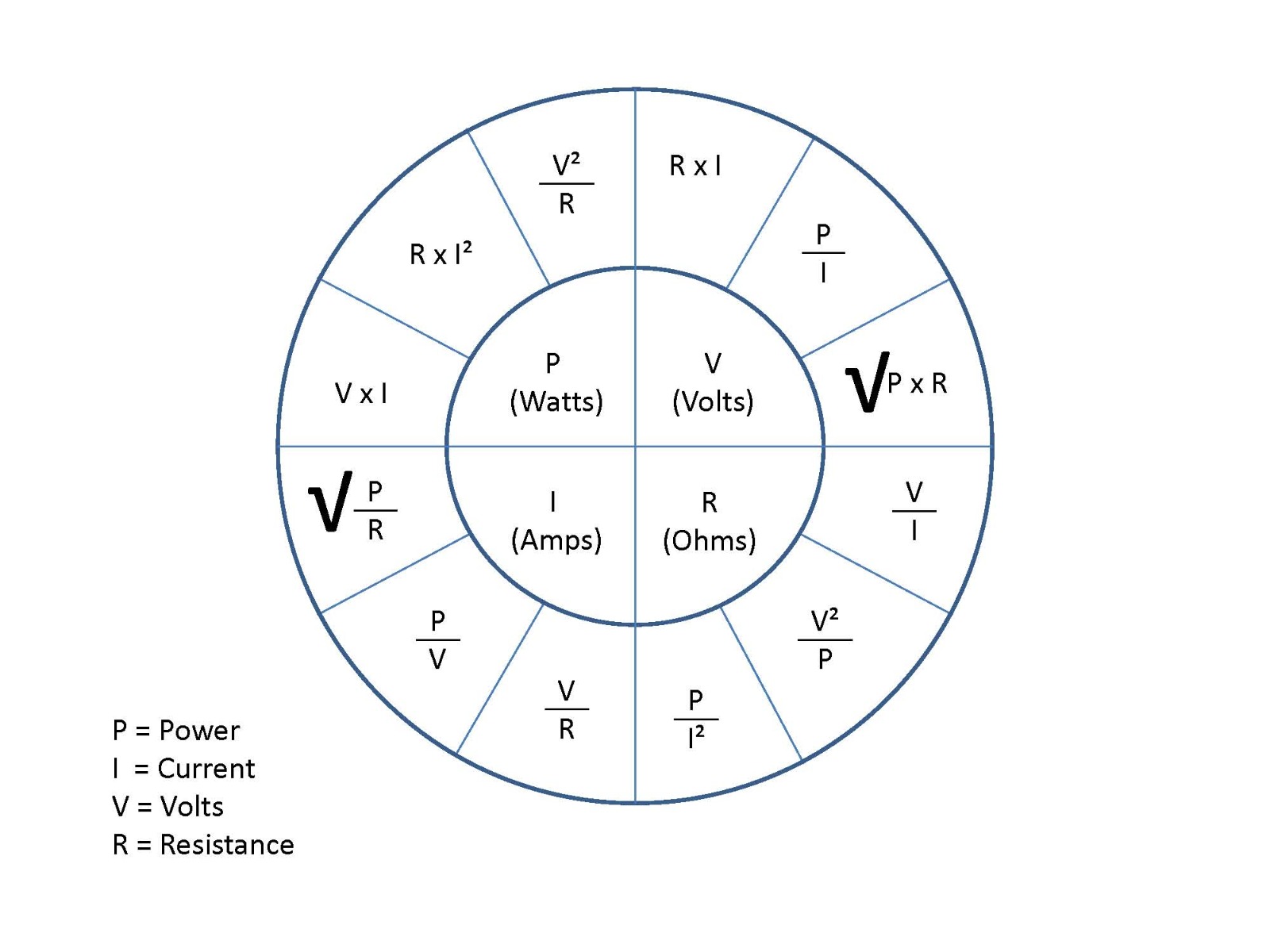
Ohms Wheel
110v, 230v or 415 ~3ph. The voltage of your supply makes a big difference to your choice of electric industrial fan heater. The lower the voltage the more limited the potential heat output.
Remember a bit of school stage physics – Ohms law which says that watts = volts x amps. (See diagram right) This means if you have a 110v supply running from a 16 Amp transformer, then the maximum power you can deliver is 1760 watts – not a lot. This is why 110v fan heaters are typically connected to a 32 amp transformer where the maximum power delivery is a theoretical 3520 watts – a bit more like it. Even this, say with a safety margin, means that the heaters connected to a 110v supply are typically going to be no more than 3kw.
A standard 230v single phase socket is on a circuit with limited amperage which is normally 30amp. But because there may be half a dozen sockets that your heater is not plugged into fans heaters are generally designed to draw no more that 3kw from a socket despite the max loading on a circuit being 6900 watts. Generally 230v heaters do not draw more than 3kw.
Higher power fan heaters need to be connected to a 415v 3 phase supply. Indeed the choice and capability of not only industrial fan heaters but all heaters, coolers, air curtains etc. dramatically increases when 3 phase supply is available, because remembering Ohms Law, not only is the voltage larger, and 3 phases the current limits can also be much larger than is the case for 110v and 230V.
Quality of Industrial Fan Heaters
The old adage ‘buy cheap, buy twice’ is as true for industrial fan heaters as for any other product. The smaller industrial fan heaters on the market are largely dominated by branded clones. That is, they are made by a far off factory with a colour and brand to match the importers requirements. Before parting company with your own or your employers’ money on a 3kw ‘industrial’ fan heater for £50, it is worth considering if it is important to you that the heater lasts for several years beyond its warranty and that spares can be obtained with ease, if for instance it needs a new set of elements. If not then buy the cheapest, but be prepared to buy another in a year or two.
Broughton FF3 industrial fan heater
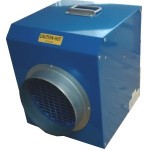
A budget industrial fan heater
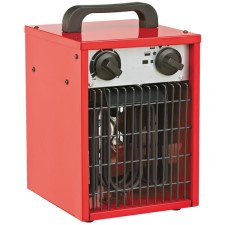
FireFlo FF3
It is easy to spot the clone industrial fan heaters just look at the detail of the grill, control, knobs, handle, position of assembly screw heads, and fold ing pattern of the elements behind the grill and you will exactly the same details on several heaters of the same size but with different colours and brands.
We do have some clone models of in our range but they are quite different to ‘proper’ industrial fan heaters. The casing and elements are much lighter weight and the casing are usually easily damaged by the odd bumps that can be expected in the workplace. On the other hand, an industrial fan heater with a heavy casing can take years of knocks but its operation not be adversely affected.
This is why our particular favourite of the from the smaller industrial fan heaters is the FireFlo FF3. We can always get spares for them and they are as tough as they get. Not only that but if your requirements change and you subsequently need to blow hot air trough a length of ducting, we can supply a flange and a duct, and the FF3 has a higher pressure fan than standard cloned fan heaters and has the grill perforations falling within a diameter designed for a duct.
Fixed or Mobile Industrial fan heater
Some of our industrial fan heaters have clever stands that can be swiveled round so that they can also be used to hang on a wall mounted hook. Whilst a useful feature the design does not allow for side to side direction setting, whereas heaters that are designed as wall mounted fan heaters will generally either have some amount of adjustment for up/down and side to side, or be designed to point down at an optimum angle for heat distribution and limited amount of horizontal plane mounting options.
Tiger industrial fan heater
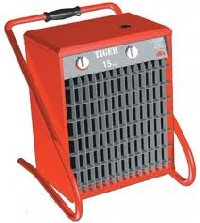
Whist the smallest industrial fan heaters will usually be free-standing units and easily carried to where ever it is needed, larger heat requirements can often be delivered from fan heaters installed on brackets mounted to walls or columns, or even slung from the roof support or ceiling structure. The choice of mobile or fixed format depends on whether the unit is for spot heating or for general heating. If for general heating then there is an advantage to having the heater supported of the wall and indeed heaters mounted in this way in smaller buildings can induce sufficient circulation within the room to prevent stratification (i.e. where the heat rises and is static under the ceiling)
Elektra Industrial Fan Heater for Extreme Environments
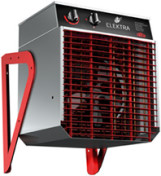
Electric industrial fan heaters that are designed for wall mounting tend to have quite lightweight casings; the reasoning being that if the heater is on a bracket out of reach then it does not need to be resistant to the same level of bumps and knocks that a free-standing unit has to endure. Even with lighter casings there is no reason why a wall mounted fan heater should not provide many years of service. They may need a new element or fan from time to time, but the casings, even though light weight, generally outlast the heater.
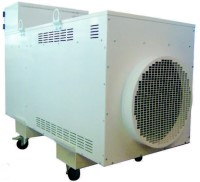
In higher output electric industrial fan heaters ‘mobility’ takes on a slightly different meaning. Some of the 3 phase heaters that we offer and have built for us are actually very large and heavy and although they can be pushed about on casters they cannot be lifted without the aid of a forklift or other lifting gear. Where manual lifting is obviously a non-starter, we ensure that the industrial fan heaters are equipped with heavy-duty braked casters, lifting eyes and forklift pockets.
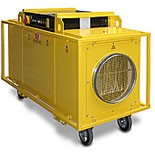
Some of the industrial heaters we offer even have outer frames to protect the bodywork from damage. Often high output heaters are a specified item and customers have exacting requirements for the units, particularly regarding fan pressure capability and control stages. This is not a problem we work with our customers to make the ideal specification to meet their needs and get the units made to order.
Ductable or Not Ductable Industrial Fan Heater
If you only need to deliver heat into the room where space heating is required then it is an easy choice; you don’t need an industrial fan heater with a duct spigot on the front. If you need a fan heater to deliver heat into a separate room, building, enclosed space or even onto part of a production process, then you need a ductable fan heater.
Ductable industrial fan heaters
Ductable industrial fan heaters have a round spigot on the front (some larger ones also have one on inlet end) for connection of flexible ducting and also that it will be equipped with a fan that is capable to delivering air along a length of flexible ducting without running out of puff. Flexible ducting, because it is corrugated (i.e. bumpy) inside, presents a considerable resistance (compared to smooth bore ducting) to moving air therefore to overcome this resistance the heater fan has to have sufficient pressure capability. The heaters need to selected for the heat output and the flow/pressure capability of the be fan. Most of our ductable models state what length of duct can be used with the heater, and on some models this can be as long as 20 or 30m.
There are applications where much more pressure is required, for delivery of hot air along much longer distances say into mines, ships holds or tunnels. These are generally achievable, however the industrial fan heater we would be proposing may be either a variation of a standard model but with a higher pressure capacity fan or a unit designed from scratch. Sometimes fan heaters are used to push hot air into a drying process and these units can generally be designed and built to deliver hot air at several thousand Pascals (Pa) if required.
Industrial Fan Heater Thermostats
The usual understanding of ‘thermostats’ is a device to regulate the heating operation according to the requirement of the ambient air temperature. However, caution is required. In recent years, some heaters have been offered as having a thermostat, when in fact they don’t. The confusion arises when thermal overload devices in the heater are miss-described as thermostats, leading people to purchase them believing that they offer a high level of control. All electric fan heaters should have thermal overload protection, otherwise they would be unsafe. Some fan heaters have ‘on board’ thermostats as standard, whilst others can have them added as optional. If on board thermostats are impractical, which is typical on wall mounted fans, there are usually options for having remote wall mounted thermostatic controllers. When considering the operation of thermostats for any heater it is worth understanding the difference between the basic ones which simply switch the heat source on and off (a single step device) and at the other end of the scale ones which offer stepless control of the heaters’ output. Some thermostats offer control based on several steps (2 step, 3 step etc.) usually based on the number of elements in the heater that can be separately fired up. This functionality can either be offered by one sophisticated device or by several basic devices preset to different temperature settings and operated by a single control knob.
Industrial Fan Heater Control Stages
A 30 kw industrial fan heater with a single speed fan and single heat output is a virtually useless machine. Control is important and the more you can get on a heater the more certain that you can be that it will meet your requirements. It is useful to have a number of fan stages as well as heat stages, as well as the ability to use the machine on ‘fan only’ is a summer bonus. most of the smaller heater we supply have 3 heat stages. Some of the larger fan heaters we supply have about 8 or so control stages, and on bespoke fan heaters we can put in control stages to suit the requirements of your application.
Output Temperature and the Delta T
Delta T is heaters trade terminology for temperature change across a heater. In the case of industrial fan heaters it is the difference between the air temperature going in and that coming out. It varies from heater to heater and indeed in any one heater it will depend in the heat setting and fan setting, however where a fan heaters specification states a delta T°C ( it means at the maximum heat and maximum air flow. It is typical of industrial fan heaters to have a ?T° of between 40 and 55°C. Where higher temperature output is required care is need because fan heaters are designed to operate within a temperature envelope so that if a heater produces a high temperature beyond its design envelope (which can happen if the airflow is restricted) then the thermal overload will switch off the elements. If you need a heater to produce a higher temperature lift, or if the heater is part of a process recirculation system, let us know and we can look into building a heater with suitably high over temperature protection devices.
Electric Power in vs. Heat Out
With electric industrial fan heaters it would be easy to assume that kw input of electricity would equal, as near as matters, heat kw output. Whilst with some electric heaters this maybe broadly the case it is not generally the case with fan heaters. The problem arises that power in and heat out are both expressed in kw, however the kw figure is arrived at using two very different methods. Electrical power in derives from current, whereas heat output derives from temperature gain on a volume of air with specific heat capacity. There is often quite a variation between a fan heaters rated power input and its actual heat output, and although most have a slightly lower output kw than power in, some cheaper heaters there can be quite a difference, e.g. 2.5kw power in and 1.8 kw power out. It becomes slightly more perplexing when you discover that some good quality fan heaters produce more heat kw out than electrical kw in. This is not kw of heat out of thin air merely an oddity of the way it is measured. Electric fan heaters are generally described by their electrical power requirement, e.g. 12kw fan would generally mean that it takes uses near 12 kw of electrical input. The lesson in all this is that industrial fan heaters are not all the same. A good quality 18 kw fan heater may produce as much as 29kw of heat whilst a poor one possibly a bit less than 18kw of heat.
Plugs, Sockets and Leads for Heaters
Single phase industrial fan heaters generally come complete with a length of flex and a fitted plug , and in the case of 110V would come with a suitable 3 round pin plug for fitting onto a transformer. With 3 phase heaters there are a greater variety of plugs and some of the smaller heaters come with a flex and plug and some come without (which comes from the belief that what ever plug was fitted it would be the wrong one). There is an assumption with larger 3 phase heaters that the users will arrange to hard wire the heater in situ for their particular application, which is why it is typical for such heaters to be equipped with a connection block but no lead. An alternative to connection block is a CEE connection socket, which is a socket but built into the heater. If you have any specific requirements on the type of plug, lead or connection point, please discuss them with us.
Running Costs of Fan Heaters
The running costs of electric heaters is actually quite easy to work out. Having selected the heater(s) you require add up their heating capacity, and multiply that figure by the electricity unit price from your supplier. This will give you a maximum hourly running cost. This running cost would only be achieved when the heaters are on and on the maximum setting. In reality running costs can be much less than this when heaters are only used when needed and only at the power setting required. With thermostatic control devices running costs are usually further reduced.


